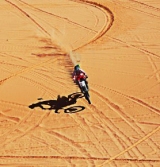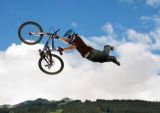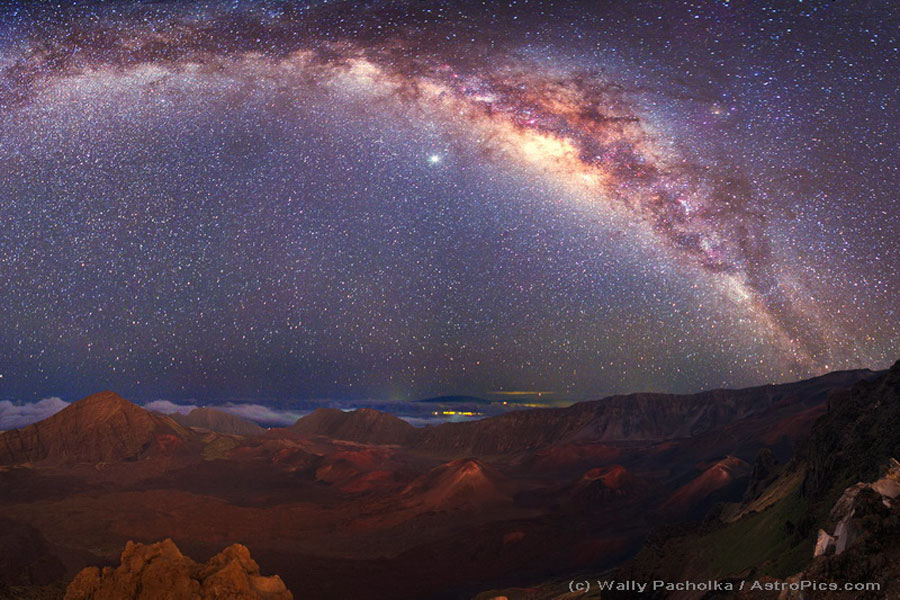- Forum
- General Discussion | Introductions | Off Topic Forum
- Photography General Discussion
- Where is the best place to photograph the milky way?
Where is the best place to photograph the milky way?
-
 Topic Author
Topic Author
- Joe Photo Daddy
- Lone Wolf
- D80
- Followers: 71
- Posts: 237
-
Points:
467
Post #300507
-

- KCook
- Photo Elder
-
- Canon EOS 50D and Olympus E-P5
- Followers: 1325
- Posts: 5410
-
Points:
32913
Post #300515
Rule 2: Near the Earth's equator. This allows you to view most of the extent of the Milky Way.
Rule 3: Away from airline routes. Airplane light trails do not help matters.
Rule 4: Higher altitude is better. Low altitude air is denser, carries more crude, resulting in less transparency.
Rule 5: Desert is better. Similar to Rule 4, only this time trying for less moisture content.
Rule 6: Whatever nice foreground you can find. Milky Way shots showing the horizon are generally prettier than those with only the sky and Milky Way.
Kelly Cook
-

- StephanieW
- Photography Hooked
-
- Canon 30D
- Followers: 11
- Posts: 852
-
Points:
0
Post #300647
If there is no observatory nearby, the above comment is perfect.
-

- effron
- Newbie
- Followers: 1623
-
Points:
129640
-

- Ian Stone
- Photo Elder
-
- Nikon D800 and Z6
- Followers: 1483
- Posts: 5025
-
Points:
39312
-

- Ian Stone
- Photo Elder
-
- Nikon D800 and Z6
- Followers: 1483
- Posts: 5025
-
Points:
39312
Post #300695
"Explanation: Have you ever seen the band of our Milky Way Galaxy? In a clear sky from a dark location at the right time, a faint band of light becomes visible across the sky. Soon after your eyes become dark adapted, you might spot the band for the first time. It may then become obvious. Then spectacular. One reason for a growing astonishment might be the realization that this fuzzy swath contains billions of stars and is the disk of our very own spiral galaxy. Since we are inside this disk, the band appears to encircle the Earth. Visible in the above image, high above in the night sky, the band of the Milky Way Galaxy arcs. The bright spot just below the band is the planet Jupiter. In the foreground lies the moonlit caldera of the volcano Haleakala, located on the island of Maui in Hawaii, USA. A close look near the horizon will reveal light clouds and the dark but enormous Mauna Kea volcano on the Big Island of Hawaii. If you have never seen the Milky Way band or recognized the planet Jupiter, this year may be your chance. Because 2009 is the International Year of Astronomy, an opportunity to look through a window that peers deep into the universe may be coming to a location near you."
apod.nasa.gov/apod/ap090127.html
-

- Ian Stone
- Photo Elder
-
- Nikon D800 and Z6
- Followers: 1483
- Posts: 5025
-
Points:
39312
-

- EOS_Fan
- Photography Hooked
-
- Canon EOS 60D
- Followers: 162
- Posts: 642
-
Points:
6154
Post #300803
Ian Stone wrote: More:
"Explanation: Have you ever seen the band of our Milky Way Galaxy? In a clear sky from a dark location at the right time, a faint band of light becomes visible across the sky. Soon after your eyes become dark adapted, you might spot the band for the first time. It may then become obvious. Then spectacular. One reason for a growing astonishment might be the realization that this fuzzy swath contains billions of stars and is the disk of our very own spiral galaxy. Since we are inside this disk, the band appears to encircle the Earth. Visible in the above image, high above in the night sky, the band of the Milky Way Galaxy arcs. The bright spot just below the band is the planet Jupiter. In the foreground lies the moonlit caldera of the volcano Haleakala, located on the island of Maui in Hawaii, USA. A close look near the horizon will reveal light clouds and the dark but enormous Mauna Kea volcano on the Big Island of Hawaii. If you have never seen the Milky Way band or recognized the planet Jupiter, this year may be your chance. Because 2009 is the International Year of Astronomy, an opportunity to look through a window that peers deep into the universe may be coming to a location near you."
apod.nasa.gov/apod/ap090127.html
I feel so small!
-

- Roblane
- Photography Hooked
-
- Nikon D600
- Followers: 117
- Posts: 505
-
Points:
2536
Post #301147
EOS_Fan wrote:
Ian Stone wrote: More:
"Explanation: Have you ever seen the band of our Milky Way Galaxy? In a clear sky from a dark location at the right time, a faint band of light becomes visible across the sky. Soon after your eyes become dark adapted, you might spot the band for the first time. It may then become obvious. Then spectacular. One reason for a growing astonishment might be the realization that this fuzzy swath contains billions of stars and is the disk of our very own spiral galaxy. Since we are inside this disk, the band appears to encircle the Earth. Visible in the above image, high above in the night sky, the band of the Milky Way Galaxy arcs. The bright spot just below the band is the planet Jupiter. In the foreground lies the moonlit caldera of the volcano Haleakala, located on the island of Maui in Hawaii, USA. A close look near the horizon will reveal light clouds and the dark but enormous Mauna Kea volcano on the Big Island of Hawaii. If you have never seen the Milky Way band or recognized the planet Jupiter, this year may be your chance. Because 2009 is the International Year of Astronomy, an opportunity to look through a window that peers deep into the universe may be coming to a location near you."
apod.nasa.gov/apod/ap090127.html
I feel so small!
I was going to say the same thing! These photos are so breathtaking
-

- Jeanne Merlo
- Snapobsessed
-
- Nikon D300
- Followers: 48
- Posts: 335
-
Points:
651
Post #301529
Ian Stone wrote: More:
"Explanation: Have you ever seen the band of our Milky Way Galaxy? In a clear sky from a dark location at the right time, a faint band of light becomes visible across the sky. Soon after your eyes become dark adapted, you might spot the band for the first time. It may then become obvious. Then spectacular. One reason for a growing astonishment might be the realization that this fuzzy swath contains billions of stars and is the disk of our very own spiral galaxy. Since we are inside this disk, the band appears to encircle the Earth. Visible in the above image, high above in the night sky, the band of the Milky Way Galaxy arcs. The bright spot just below the band is the planet Jupiter. In the foreground lies the moonlit caldera of the volcano Haleakala, located on the island of Maui in Hawaii, USA. A close look near the horizon will reveal light clouds and the dark but enormous Mauna Kea volcano on the Big Island of Hawaii. If you have never seen the Milky Way band or recognized the planet Jupiter, this year may be your chance. Because 2009 is the International Year of Astronomy, an opportunity to look through a window that peers deep into the universe may be coming to a location near you."
apod.nasa.gov/apod/ap090127.html
What gear was used to take that photo?
-

- Rudy Sosa
- Snapobsessed
-
- Canon 5D Mark III
- Followers: 74
- Posts: 319
-
Points:
2350
-

- KCook
- Photo Elder
-
- Canon EOS 50D and Olympus E-P5
- Followers: 1325
- Posts: 5410
-
Points:
32913
-

- MajorMagee
- Photography Hooked
-
- E-PL1, E-PL2, E-PM1, E-P5
- Followers: 13
- Posts: 739
-
Points:
0
-

- Sawyer
- Master of the Lens
-
- Canon 5D Mark II
- Followers: 248
- Posts: 1862
-
Points:
13181
- Forum
- General Discussion | Introductions | Off Topic Forum
- Photography General Discussion
- Where is the best place to photograph the milky way?
Latest Reviews
The Olympus Pen E-P7 is an affordable micro four thirds mirrorless camera with 4K video capabilities, a 20.3MP sensor, and 121 focus points, making it a solid entry-level camera for beginners.
The Panasonic G9 II is a 25.2-megapixel micro four thirds camera with numerous features that make it punch out of its weight class, like 779 AF points, 5.8K video, and weather sealing.
The Fujifilm XT5 is a 40MP mirrorless camera capable of 6.2K video at 30p. With those specs, it’s an ideal choice for photographers needing a camera to pull double duty for imaging and video.
The Canon EOS R100 is an entry-level mirrorless camera introduced in 2023. But just because it’s an entry-level camera doesn’t mean it’s a bare-bones camera. Find out why in this review!
Forum Top Posters
-
1Scotty 7 posts
-
2TCav 6 posts
-
3Ruby Grace 4 posts
-
4Street Shark 4 posts
-
5CharleyL 3 posts
-
6Roger Lang 3 posts
-
7Nefarious 3 posts
-
8Sassy Girl 2 posts
-
9Carter Gledhill 2 posts
-
10Garbo 2 posts
Latest Articles
The Olympus Pen E-P7 is an affordable micro four thirds mirrorless camera with 4K video capabilities, a 20.3MP sensor, and 121 focus points, making it a solid entry-level camera for beginners.
Starting a photography business is one thing; sustaining your business over a long period of time is another. Use the tips in this professional photography guide to build something with longevity!
The Panasonic G9 II is a 25.2-megapixel micro four thirds camera with numerous features that make it punch out of its weight class, like 779 AF points, 5.8K video, and weather sealing.
Cinematic photography is an interesting genre that combines photographic and videographic skills along with effective storytelling techniques. The result? Highly impactful images!
Newborn photography requires skill, the right gear, and a lot of patience. This beginner’s guide discusses critical topics that will help you be more prepared for before, during, and after the shoot.
To fill the frame means to expand the footprint of the subject in your shot. Get in close, zoom in, crop the image, or use other techniques to bring the subject to the forefront.
With these simple yet effective beginner photography tips, you can avoid some of the common mistakes beginners make and get improved results with your images.
Urban photography is a genre showcasing features in urban settings. You can photograph people, architecture, mass transit, and many other subjects. Learn how to do so in this guide!

















